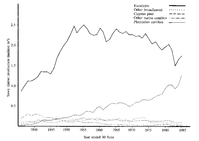


Chapter 4
I Management Of Native Forests
II Plantations-high Productivity Resources
III Protecting The Resource
IV Harvesting The Resource
V Solid Wood And Its Processing
i Sawmilling
ii Drying
iii Preservation
iv Quality and standards
VI Minor Forest Products
VII Reconstituted Wood Products
VIII Pulp And Paper
IX Export Woodchips
X Future Directions
XI Acknowledgements
References
Index
Search
Help
Contact us

Sawmilling (continued)
After the Second World War plantation pine sawmilling was developed in other States too, slowly at first but at an accelerating rate through the 1960s, as more and more sawlogs became available. The technology used was essentially that well-proven overseas for similar woods. The new pine sawmills, however, evolved somewhat differently from the native forest hardwood mills. Being generally located close to large plantation areas they tended to be of a larger scale and this favoured the use of modern technology and a high degree of mechanization. Moreover, because of the higher cost of the plantation wood more attention was paid to achieving the best utilization pattern. Thus the best quality logs were directed to veneer and plywood manufacture and thinnings and tops too small for sawmill use were sold as posts and poles after preservative treatment or sent, generally in chip form, to particleboard mills or pulp mills. Saw mill edgings and offcuts were also directed to these uses and to an increasing degree chipper-canters were introduced to square logs and produce chips from the removed portions simultaneously. The integrated industries that have been based on these large and efficient pine sawmills have become increasingly important components of the overall forest products economy.The Australian sawmilling industry currently supplies about 70 per cent of domestic demand, the balance being made up by softwood imports from North America and New Zealand and hardwoods, mainly from South-east Asia. Its changing raw material base over the past 50 years (the period for which adequate data are available) is illustrated in Figure 8. The increasing dependence on plantation pine, the marked fall in eucalypt usage since the 1960s and the small and decreasing usage of other native woods are clearly seen.
Along with these changes has been a decline in the per capita consumption of sawn timber, which peaked at about 0.45 m3/yr in the mid-1950s and then fell, to lie in the range 0.22-0.29 m3/yr in the first half of the 1980s. An important factor in this has been the increasing penetration of traditional timber markets by other materials, in particular concrete, steel, aluminium, plastics, reconstituted wood panel products and paperboard. The continued swing to plantation pine and larger sawmills should, however, give further productivity gains which may improve the competitive position of sawn timber.

 |
Australian Academy of Technological Sciences and Engineering |  |
© 1988 Print Edition pages 219 - 220, Online Edition 2000
Published by Australian Science and Technology Heritage Centre, using the Web Academic Resource Publisher
http://www.austehc.unimelb.edu.au/tia/228.html